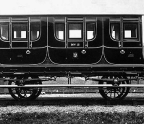

Please note the convention used in this article: telegram codes are rendered in the upper case as they always were, and their interpretations in italics – for example, ACK means Acknowledge receipt by wire. This avoids a proliferation of quotation marks!
The origins of the telegraph
Cumbersome efforts to send messages by electro-static discharges along wires started in the mid-eighteenth century. The voltaic pile – the first battery, invented by Alessandro Volta in 1799 – provided a continuous current of low voltage electricity. Hans Christian 0ersted discovered in 1820 that an electric current produces a magnetic field that will deflect a compass needle and other inventors developed the use of a coil of wire to enhance the electro-magnetic effect.
In the 1820s and ‘30s numerous experimental systems using suspended needles were developed. By reversing the polarity of the current a bar (‘needle’) mounted vertically on a pivot at its centre could be made to deflect to left or right. Carl August von Steinheil developed a compact needle instrument in which a deflection of the needle struck one of two bells mounted left and right. The operator could thus detect a message without having to watch the instrument constantly. Later, needle stops of dissimilar materials such as ivory and metal were used.
Such a system requires codes for each letter – for example, left-left-right (ping-ping-pong) denoting E. In the 1840s Samuel Morse and collaborators in the USA developed an armature-based telegraph system which used a code based on short (‘dot’) and long (‘dash’) electrical pulses and pauses between them, the pulses creating audible clicks. The Morse code could be used with a single-needle telegraph through deflections left for dots and right for dashes.
In May 1837 William Fothergill Cooke and Charles Wheatstone patented a telegraph system using several needles mounted on a board carrying the alphabet in a diamond array. The simultaneous




